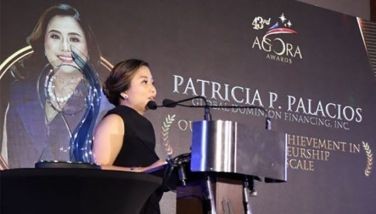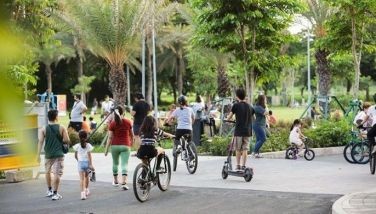The road to Ilocos
On the last morning of a three-day road trip to the Ilocos, I walk along the shoreline of Fort Ilocandia Resort in Laoag. Lowland pines line the path to the long stretch of black sand beach that opens to the South China Sea. Its raw beauty stands in contrast to the Spanish-inspired dwellings and the well-manicured lawns of the resort. I pick up stones in shades of earth and gray — solid in shape and form — reminding me of the Ilocano landscape and the stories I’ve heard of its industrious and hardy people. I first heard their stories from National Artist for literature, F. Sionil Jose, a native Ilocano and a writer who has gained international prominence for his searing portrayal of Philippine social realities. He’s often told me about his forebears who left the village of Cabugaw, in Ilocos Sur to start a new life in Pangasinan — taking with them their customs and traditions, their work ethic and way of life. The stories of Ilocano men and women, the challenges they faced and their formidable qualities are explored in Jose’s novel,Dusk, the first of five novels in the highly acclaimed “Rosales Saga.” The novels span a century as it traces the history of a town and its families against the backdrop of Philippine history.
Over the last few years, we’ve talked about taking a trip together to the Ilocos — which for Jose is part-nostalgia, part-literary and part-historical. Many of the country’s political and literary figures hail from the north — Diego and Gabriela Silang who first led the fight for Philippine independence, Presidents Elpidio Quirino and Ferdinand Marcos, writers like Pedro Bukaneg (the father of Ilocano literature) and Manuela Arguilla (whose stories depicted barrio life in Bawang, La Union). Here, too, was the site of peasant rebellions and uprisings, the battles fought between American soldiers and our barefoot soldiers who faced a certain death yet fought with bravery and valor — stories we should not forget. The novel Dusk is about these humble yet extraordinary men. And literature, Jose points out, “is the noblest of arts because it touches the mind and the heart.”
 Crisologo Street in Vigan is a UNESCO World Heritage Site.
Crisologo Street in Vigan is a UNESCO World Heritage Site. We set out for our road trip to the Ilocos in mid-June. It would take us nine hours to reach Vigan in Ilocos Sur as we headed up the north expressway taking us to Bulacan, Pampanga, Tarlac, and the sprawling grounds of Hacienda Luisita. From there it was a long stretch to Pangasinan — Sionil Jose’s hometown. All through the trip Jose talked about Philippine history and how the Ilocos and the Ilocanos played a vital role in shaping the nation’s story. Here, both common and great men gave spirit and momentum to the many uprisings that took root in various parts of the Ilocos — all for the cause of freedom and justice. Then, Jose tells me about Apolinario Mabini, who he describes as “the real idealogue behind the revolution and a man of great integrity.” Mabini sought refuge in Rosales, Pangasinan before his capture in Nueva Ecija. “Here was a man who was, in a sense, the first foreign affairs minister of the Philippines, who stated the Philippine position in the Treaty of Paris of 1898 and is still not given the recognition he deserves because we Filipinos have short memories,” Jose explains. When we reach Pangasinan, he leaves the subject of heroes and tells me that this is virtually Ilocano country as many native Ilocanos cleared the land and chose to settle here. “The Ilocos is a very narrow coastal plain, where the mountains like the Cordilleras drop right down to the sea. Sooner or later, because of the scarcity of land, the Ilocanos had to seek land and the promise of a better life elsewhere,” Jose points out. Many Ilocanos had also been dispossessed of their land as far back as the Spanish regime during the 1880s. In their search for a better life in new parts, the Ilocanos brought everything with them — in covered wagons outfitted with solid molave wheels they carried weaving looms, farming implements, wooden posts uprooted from their homes, bamboo baskets and cloth for weaving the “Abel Iloko” crafts that are still made these days. So it was that the Ilocanos took their customs, the traits of hard work, frugality and independence wherever they went and for which they are still known. In Pangasinan, Jose goes down memory lane as we reach the town of Rosales, pointing out the site of his old elementary school, the river where he swam with fellow schoolboys, the watermelons they would bring to cool in the river waters, the old lamppost where he would read the classics of literature late into the night — such books were translated into Ilocano and sold in the public market side by side with salted fish. It was not long after that an abiding curiosity for life and literature was born. From the tales of village elders about life in the last years of the Spanish regime, questions would crop up about justice, freedom and Philippine social conditions that would become the subject and object of Jose’s writing.
 The statue of the most famous Ilocana writer of the Spanish period, Leona Florentino. Her works were translated into different languages but the original copies were destroyed during the Philippine Revolution. This statue sits at the foot of Crisologo St. in Vigan, Ilocos Sur.
The statue of the most famous Ilocana writer of the Spanish period, Leona Florentino. Her works were translated into different languages but the original copies were destroyed during the Philippine Revolution. This statue sits at the foot of Crisologo St. in Vigan, Ilocos Sur. We stop at Tayub, the site of the Colorum Uprising of 1931, a revolt led by peasant farmers who set the municipal hall ablaze — fighting for the principle that the land was the property of all men and not just the province of a few. The scene is described in Jose’s novel, The Pretenders. From there we proceed to Binalonan, the home of Ilocano novelist and poet Carlos Bulosan, who wrote about the struggle of the labor classes in the Philippine and the conditions of Filipino migrant laborers in California. Then it was on to La Union, to visit the hometown of the writer, Manuel Arguilla who depicted scenes of life in Barrio Nagrebcan in Bawang, La Union. Arguilla secretly organized a guerilla intelligence unit against the Japanese and was executed by the Japanese army in Fort Santiago in 1944.
Along the road we see sign of progress — shopping malls, fast-food chains, bustling public markets and open squares. Towards Ilocos Sur, a beautiful landscape of lush and verdant fields comes into view, resembling an Amorsolo painting. We would see many such vistas driving through the Ilocos along with large, well-tended homes built by prosperous Ilocanos — painted in lively pastel colors, bounded by gardens and set back from the main road. Here the streets are bordered with painted stones and flowering bushes. As we drive past these areas, Jose tells me, “Ilocanos like to keep their towns orderly and to beautify their surroundings.”
 Images of saints in wood in a store on Crisologo St.
Images of saints in wood in a store on Crisologo St. It is almost dark when we reach the town of Candon in Ilocos Sur. Candon first established a revolutionary government in 1898 though it was short-lived as the Spaniards reoccupied the area. We stop at the Candon Church, the first of a number of churches we would visit in this region known for its imposing religious structures and devout people. The 400-year-old church is adorned with beautiful frescoes said to be the longest religious paintings in the Philippines, representing the 20 mysteries of the Holy Rosary.
After the brief stop in Candon, we press on to Vigan. We arrive in time for dinner and stop at the Vigan Plaza hotel for an overnight stay. Entering old town square, declared a UNESCO world heritage site, we sight huge trees sparsely lit by lanterns. Adjacent to the square, is Crisologo Street and its cobbled-stone paths lined with Spanish-colonial style homes. Vigan was the most progressive town in the Spanish regime during the 18th and 19th century, and the center of the Indigo trade. “Some of the very old houses here were the result of that very prosperous trade with Europe,” says Jose. By day, the street is a hub of commercial activity as storefronts brim with crafts and furnishings in wood, woven bags and basketry, the images of saints and an array of souvenirs. Across the Vigan Plaza hotel, a 100-year-old Bibingka house still draws a crowd. The tasty rice cakes are more like custard pies in flavor and consistency and come individually wrapped and packaged in boxes. Outside, hawkers are plying glutinous rice cakes encased in young bamboo tubes known as bolo. At the foot of Crisologo Street, we come upon the statue of Leona Florentino, who is known as the finest woman writer and poet of the Spanish period and whose works were translated into different languages.
 The Bantay belfry sits on a hilltop just a few meters away from Bantay Church.
The Bantay belfry sits on a hilltop just a few meters away from Bantay Church. After exploring Crisologo Street, we stop at the Vigan Cathedral, the center of Catholic faith in the north in the 18th century. The Baroque-style structure has an impressive silver-paneled main altar, three naves and 12 minor altars. After a brief stop at the Cathedral, we proceed to the Panburnayan factory. The making of the Burnay pottery began before the Spanish times, when migrants from China settled in Vigan and practiced the craft of making earthenware using high-quality clay sourced from the western parts of Vigan. At first the jars were intended for storing food and local wine but these days they are used as decorative pieces for homes and gardens. The jars have found a following in Manila and Bulacan, and are exported to Europe. From there it is a short drive to Vigan’s Hidden Garden. A gated compound conceals this garden where a treasure trove of plants are set in different landscape styles and forms — Japanese, bamboo or rainforest. It is a refreshing stop in a city that is populated with historical landmarks.
Back at the Vigan Plaza hotel, my travel mates were sharing a mixed Ilocano platter for lunch consisting of Pinakbet, Vigan longaniza, Bagnet and a traditional goat stew swimming with innards and flavored with bile juice. I opted for a cold Thai chicken salad as the rising heat and humidity were beginning to sap my energy. There was still so much to see on the road from Vigan to Laoag. From here on, we would stop at the churches of Bantay, Magsingal, Sarrat and Paoay. I’ve been told that these churches were not just places of worship but served as sanctuaries for the townspeople, and in some cases, defensive structures against invaders and observation posts for revolutionaries.
 Burnay pottery in a factory located in Vigan
Burnay pottery in a factory located in Vigan “I have been to these churches countless times — taking visiting writers and friends from abroad. By the time they reach Paoay, they all suffer from church fatigue!” recounts Jose. The Church of Bantay has special meaning for him as it is cited in the opening pages of his novel, Dusk. Bantay was where the old Augustinian friars went when they retired. It is situated across the river from Vigan. Jose says it is an unusual church with the belfry located a distance away from the church. The belfry sits on a hilltop overlooking green pastures and offers mountain views towards the province of Abra. Father Isacio Rodriguez, an old friend and eminent Spanish historian once told Jose that most of these churches served as forts — offering shelter and refuge to the locals against invading Moro pirates who came to capture slaves for their trades and their homes in Sulu and Mindanao. At the church of Magsingal, Jose tells me, “Pay special attention to the intricately carved altar, it is one of the most beautiful altars in the Philippines.” At Paoay, we visit the church that is a UNESCO world heritage site. The facade of the church from both the side and the front are impressive structures in stone. At first glance, the thick buttresses on either side of the church recall Asian temple structures. The bell tower of the church served as an observation post for the Katipuneros in 1896 and the guerrillas during the Japanese occupation. The church of Sarrat in Ilocos Norte sits on scenic spot — across a tree-lined promenade on the banks of the Padsan River. You would never guess from the simple brick façade that it is the largest church in Ilocos Norte. It was intended for the capital city that Sarrat had been for a time until the capital was shifted to Laoag due to its larger landmass. Sarrat is the birthplace of President Ferdinand Marcos. The church is better known in our day as the venue of the wedding of Irene Marcos to Greggy Araneta and had been painstakingly restored by Mrs. Imelda Marcos for the occasion. Owing to the bad weather conditions at the time of our trip, the church closed before we arrived and I was unable to see its interior.
As we drive towards Laoag, we pass roads and towns that are clean and orderly true to the Ilocano tradition that Jose told me about. Much of the progress in these parts can be attributed to President Marcos. “Marcos improved the infrastructure and irrigation systems, and the lot of the farmer by abolishing the old system of tenancy in rice and corn lands which had been the source of injustice and unrest in the rural areas. He granted farmers leasehold rights and security of tenure,” says Jose. Remembering the Marcos years, Jose adds: “Marcos had a true vision for the Philippines — he wanted to promote the Philippines as a progressive nation which it was at the time but he strayed from that vision.”
We arrive at our final destination: The Fort Ilocandia Resort in Laoag for an overnight stay. In contrast to the compact and intimate interiors of the Vigan Plaza hotel, Fort Ilocandia is a vast complex that includes a casino, several restaurants, an Internet café, a large swimming pool and a sandy beach that opens to the South China Sea. After a few days of immersion in the history of the region, soaking up stories of the local culture, and its larger-than-life personalities, it seemed like a good idea to end the trip on a quiet note — to take a breather by the sea and reflect on what it all means. Nothing takes the place of walking through the well-trodden paths of history where ordinary men and heroes once met, where the tales of life abound — in our colonial past, in the struggle for justice, in the forging a local and national identity and what it means to be a Filipino. This is what coming to the Ilocos has been for me. As I head back home, I come upon the familiar sight of vast, open fields that glisten with the late-afternoon light — a melancholy landscape that mirrors the stories I’ve heard of the Ilocos — of the men and women who were forced to seek a better life in other parts, who cultivated the land and reshaped the landscape, and invariably touched the lives so many others along the way — all for the greater good.



















